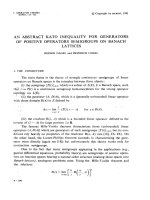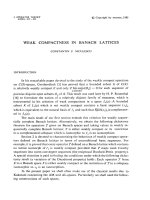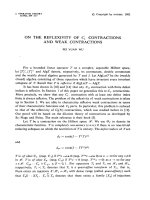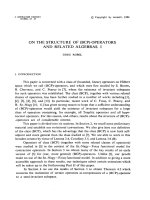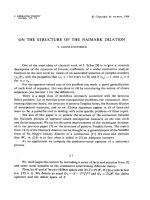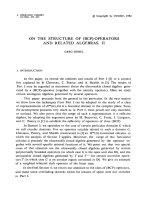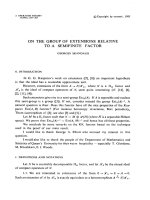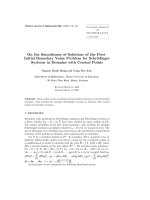Báo cáo toán học: "On the h-Vector of a Lattice Path Matroid" pot
Bạn đang xem bản rút gọn của tài liệu. Xem và tải ngay bản đầy đủ của tài liệu tại đây (103.33 KB, 6 trang )
On the h-Vector of a Lattice Path Matroid
Jay Schweig
Department of Mathematics
University of Kansas
Lawrence, KS 66044
Submitted: Sep 16, 2009; Accepted: Dec 18, 2009; Published: Jan 5, 2010
Mathematics Subject Classification: 05B35, 05E45
Abstract
Stanley has conjectured that the h-vector of a m atroid complex is a pure M-
vector. We pr ove a strengthening of this conjecture for lattice path matroids by
constructing a correspon ding family of discrete polymatroids.
1 Introdu ction
The h-vector of a finite simplicial complex is arguably its most studied invariant. The
following conjecture of Stanley [13] has sparked a great deal of research into the h-vectors
of matroid complexes (see Hibi [9], Swartz [14, 15], Chari [5], and Hausel and Sturmfels
[6]).
Conjecture 1.1. The h-vector o f a matroid complex is a pure M-vector (i.e., the degree
sequence of a pure monomial order ideal).
Conjecture 1.1 has been proven for cog r aphic matroids by both Merino [11] and Chari
(unpublished).
Lattice path matroids, introduced by Bonin, de Mier, and Noy in [3] and studied
further in [4], are special transversal matroids whose bases can be viewed as planar lattice
paths. Subclasses of such matroids appeared in [1] and [10]. We show that Stanley’s
conjecture holds for lattice path matroids by constructing an associated family of pure
monomial order ideals. We then strengthen our r esult by showing that these monomial
order ideals are in fact discrete polymatroids, in the sense of Herzog and Hibi [7].
2 Preliminaries
We assume a basic familiarity with matroid theory (see, for instance, [12]).
the electronic journal of combinatorics 17 (2010), #N3 1
Recall that the f-vector of an (r−1)-dimensional simplicial complex ∆ is (f
0
, f
1
, . . . , f
r
),
where f
i
counts the number of (i − 1)-dimensional faces of ∆, and that the h-vector of ∆
is the sequence (h
0
, h
1
, . . . , h
r
), where
r
i=0
f
i
(t − 1)
r−i
=
r
i=0
h
i
t
r−i
.
The f- and h-vectors of a matroid M are those of its independence complex (the
simplicial complex whose faces are the independent sets of M). The h-vector of M is also
given by the coefficients of T (x, 1), where T (x, y) is the Tutte polynomial of M (see [2]).
For simplicity, all our matroids will use the ground set [n + r], for positive integers n
and r. (Here and throughout, [k] = {1, 2, . . . , k}.) When B is a basis of a matroid M , we
call i ∈ B internally active if (B\i) ∪ j is not a basis for any j < i. The following lemma
can be found in [2].
Lemma 2.1. Let (h
0
, h
1
, . . . , h
r
) be the h - vector of a matroid M. For 0 i r, h
i
is the
number of bas es of M with r − i internally active elements.
A sequence (h
0
, h
1
, . . . , h
r
) of nonnegative integers is an M-vector if there exists a
monomial order ideal Γ containing, for all i, h
i
elements of degree i. Some authors,
including Stanley in [13], call these objects O-sequences. An M-vector is called pure if
there exists a monomial order ideal Γ as above with no maximal element of degree less
than r. Not all M-vectors are pure (for example, (1, 3, 1)).
3 Lattice path matroids
Let A = {A
1
, A
2
, . . . , A
k
} be a collection of subsets of [n + r]. Recall that a subset
T ⊆
k
i=1
A
i
is a partial transversal of A if there exists an injection φ : T → [k] such
that t ∈ A
φ(t)
for all t ∈ T . The partial transversals of A ar e the independent sets of the
transversal ma troid defined by A (see [12]), which we denote as M(A).
Definition 3.1. Let A = {[a
1
, c
1
], [a
2
, c
2
], . . . , [a
r
, c
r
]}, where each a
i
c
i
, each [a
i
, c
i
] =
{a
i
, a
i
+ 1, . . . , c
i
} is an interval in the integers, 1 a
1
< a
2
< · · · < a
r
, and c
1
< c
2
<
· · · < c
r
n + r. Then M(A) i s called a lattice path matro id.
For our purposes, a lattice path σ to (n, r ) is a sequence of unit-length steps, each either
directly north or east, beginning at the origin and terminating at (n, r). If B ⊆ [n + r]
and |B| = r, define a lattice path σ
B
to (n, r) by the following rule: the i
th
step of σ
is north if and only if i ∈ B. Although the path σ
B
depends up on the point (n, r), we
suppress this from the notation.
For t he remainder of this section, let A be a collection of sets as in Definition 3.1, let
A = {a
1
, a
2
, . . . , a
r
} and C = {c
1
, c
2
, . . . , c
r
}, and assume all lattice paths terminate at
the point (n, r). The following propositions are shown in [3].
Proposition 3.2. A set B ⊆ [n + r] with |B| = r is a basis of M(A) if and only if the
path σ
B
(weakly) lies between the paths σ
A
and σ
C
.
Proposition 3.3. Let B ⊆ [n + r] be a basis of M(A). Then i ∈ B is internally active if
and only if the i
th
step of σ
B
(which is a north step, by definition) coincides with a north
step of σ
A
.
the electronic journal of combinatorics 17 (2010), #N3 2
If σ is a path between σ
A
and σ
C
, call a north step of σ tight if it coincides with a
north step of σ
A
. Otherwise, call it loose. We use these terms only to refer to vertical
steps. Lemma 2.1 and Proposition 3.3 immediately imply the following.
Corollary 3.4. Let (h
0
, h
1
, . . . , h
r
) be the h-vector of M(A) . Then for all i, h
i
is the
number of lattice paths between σ
A
and σ
C
that have e xactly i loose steps .
Remark 3.5. In ge neral, a rank-r matroid M with coloop e has (h
0
, h
1
, . . . , h
r−1
, 0) as
its h-vector, where (h
0
, h
1
, . . . , h
r−1
) is the h-vector of the deletion M\e. Thus, we may
restrict our attention to coloop-free matroids. The matroid M(A) is coloop-free if and
only if each a
i
< c
i
.
Theorem 3.6. The h-vector of a lattice path matroid is a pure M-vector.
Proof. Let A, A, and C be as above. We construct a pure monomial order ideal Γ whose
elements are in bijection with the lattice paths between σ
A
and σ
C
such that the degree
of the monomial corresponding to a path σ is the number of loose steps of σ. Given
Corollary 3.4, this will prove the theorem.
Let σ be a path between σ
A
and σ
C
. Define the monomial m(σ) as follows: for each
loose step of σ along the line x = i, include a copy of x
i
in m(σ). (See Figure 1.) Let
Γ = {m(σ) : σ is a path between σ
A
and σ
C
}.
4
x x xx
1 2 3
Figure 1: A lattice path σ with m(σ) = x
2
1
x
3
.
Let m(σ) ∈ Γ have degree less than r, and suppose that the highest tight step of σ
is on the line x = i. Then the next step o f σ must be an east step. Letting σ
′
be the
path o bta ined from σ by changing this la st tight step to an east step and fo llowing it by
a north step, we see that m(σ
′
) = m(σ)x
i+1
. By Remark 3.5, σ
′
lies between σ
A
and σ
C
.
Continuing in this way, we eventually obtain a degree-r monomial in Γ divisible by m(σ),
which shows that Γ is pure.
To see that the correspondence σ → m(σ) is injective, consider m = x
e
1
i
1
x
e
2
i
2
· · · x
e
m
i
m
∈ Γ
with i
1
< i
2
< · · · < i
m
and each e
j
> 0. We show that there is a unique way to construct
a path σ between σ
A
and σ
C
such that m(σ) = m. Start at the po int (n, r). First, travel
to the line x = i
m
by taking west steps, except when forced to take south steps by the path
σ
A
. Second, take all forced tight south steps and then e
m
loose south steps. Continue this
process by traveling to the line x = i
m−1
, and so on. This clearly produces the unique
path σ with m(σ) = m. Moreover, if m = m
′
x
j
for some j, simply modify the above
algorithm to take one fewer south step along x = j. The resulting path corresponds to
the monomial m
′
, which proves t hat Γ is an order ideal.
the electronic journal of combinatorics 17 (2010), #N3 3
4 Discrete polymatroids
In [7], the authors introduce discrete polymatroids, which generalize matroids in the way
monomial order ideals generalize simplicial complexes. Further algebraic properties of
these objects were studied in [8]. The definition in [7] involves integer vectors, but we
treat these sequences as exponents of monomials. All our monomial order ideals use the
variables {x
i
}. If m is a monomial, let m
i
denote the degree of x
i
in m.
Definition 4.1. A monomial order ideal Γ is a discrete polymatroid if, whenever m, m
′
∈
Γ with deg(m) > deg(m
′
), there is some i such that m
i
> m
′
i
and m
′
x
i
∈ Γ.
The following proposition is shown in [7].
Proposition 4.2. A p ure mono mial order ideal Γ is a discrete polymatroid if and only
if, for any two maximal monomials m, m
′
∈ Γ and index i with m
i
> m
′
i
, there exists an
index j such that m
j
< m
′
j
and
x
j
x
i
m ∈ Γ.
If we require that all monomials be squarefree, Definition 4.1 and Proposition 4.2
specialize to classical matroid axioms.
Theorem 4.3. The mon omial order id eal Γ constructed in the proof of Theorem 3.6 is a
discrete polymatroid.
Proof. (We are indebted to Joe Bonin for his significant simplification of our original
proof.) Let A, A, C, and Γ be as in Theorem 3.6, and set A
+
= {a
1
+1, a
2
+1, . . . , a
r
+1}.
By Remark 3.5, the path σ
A
+
does not cross the path σ
C
. It is clear that the set of
degree-r monomials of Γ is { m(σ) : σ is a path between σ
A
+
and σ
C
}. We show that these
monomials satisfy the condition of Proposition 4.2.
Let σ and σ
′
be two paths in between σ
A
+
and σ
C
, with m(σ)
i
> m(σ
′
)
i
. We will show
that there is some j with m(σ)
j
< m(σ
′
)
j
and some path ˆσ in between σ and σ
′
so that
m(ˆσ) =
x
j
x
i
m(σ). Let q be the greatest integer so that the point (i, q) is on the path σ,
and define q
′
analogously for the path σ
′
.
First, supp ose that q > q
′
. Since the paths σ and σ
′
intersect at their common terminal
point, there must be a j > i such that m(σ)
j
< m(σ
′
)
j
. Choose j to be minimal with
this property (but still greater than i). Then every east step of σ between the lines x = i
and x = j is strictly above an east step of σ
′
. Let t be the least integer so that (j, t) lies
on the path σ. D efine a new path ˆσ from σ as follows: delete the north step going from
(i, q − 1) to (i, q), and add a new north step going from (j, t − 1) to (j, t). Then move the
part of B going from (i, q) to (j, t) down a unit step. Since q > q
′
and j was chosen to be
minimal, the resulting path ˆσ is between σ and σ
′
. Because ˆσ has one more north step
than σ along the line x = j and one fewer than σ along the line x = i, m(ˆσ) =
x
j
x
i
m(σ).
Next suppose that q q
′
. Because m(σ)
i
> m(σ
′
)
i
, σ has more north steps along
the line x = i than σ
′
. Rotating everything by 180 degrees, we return to the first case
considered.
Definition 4.4. We call a sequence (h
0
, h
1
, . . . , h
r
) a PM-vector if it is the degree sequence
of some discrete polymatroid Γ.
the electronic journal of combinatorics 17 (2010), #N3 4
Every PM-vector is a pure M-vector (by definition), but the converse does not hold: the
M-vector (1, 4, 2) is pure but not PM. Thus, the following corollary strengthens Theorem
3.6.
Corollary 4.5. The h-vector of a lattice path matroid is a PM-vector.
Given the above corollary, it seems natural to ask the following.
Question 4.6. Which matroids have h-vectors that are PM-vectors?
In [1 1], Merino proves Conjecture 1.1 for cog raphic matroids. Although the pure
monomial order ideals constructed in his proof are rarely discrete polymatroids, we have
yet to find a matroid (cographic or otherwise) whose h-vector is not a PM-vector.
Acknowledgements. My thanks go to Joe Bonin and Ed Swartz for many helpful discus-
sions, a nd to the anonymous referee for numerous edits and suggestions.
References
[1] F. Ardila, The Catalan matroid, J. Combin. Theory Ser. A 104 (1) (2003), 49-62.
[2] A. Bj¨orner, The homology and shellability of matroids and geometric lattices, In
Matroid Applications, N. L. White, ed., Cambridge University Press, Cambridge
(1992) 226-283.
[3] J. Bonin, A. de Mier, and M. Noy, Lattice path matroids: enumerative aspects and
Tutte polynomials, J. Combin. Theory Ser. A 104 (1) (2003), 63-94 .
[4] J. Bonin and A. de Mier, Lat t ice path matroids: structural properties, European J.
Combin. 27 (5) (2006), 701-738.
[5] M.K. Chari, Two decompositions in topological combinatorics with applications to
matroid complexes, Trans. Amer. Math. Soc. 349 (10) (1997), 3925-3943.
[6] T. Hausel and B. Sturmfels, Toric hyperK¨ahler varieties, Doc. Math. 7 (2002), 495-
534 (electronic).
[7] J. Herzog and T. Hibi, Discrete polymatroids, J. Algebraic Combin. 16 (3) (2002),
239-268.
[8] J. Herzog, T. Hibi, and M. Vladoiu, Ideals of fiber typ e and polymatroids, Osa ka J.
Math. 42 (4) (2005), 807- 829.
[9] T. Hibi, What can be said about pure O-sequences? J. Combin. Theory Ser. A 50
(2) (198 9), 319-322.
[10] C. Kliva ns. Shifted Matroid Complexes . PhD thesis, Massachusetts Institute of Tech-
nology, 2003 .
[11] C. Merino, The Chip Firing Game and Matroid Complexes, in Discrete Models:
Combinatorics, Computation, and Geometry, DM-CCG 2 001, R. Cori, J. Mazoyer,
M. Morvan, and R. Mosseri, eds., Discrete Mathematics and Theoretical Computer
Science Proceedings AA ( 2001), 245-256.
the electronic journal of combinatorics 17 (2010), #N3 5
[12] J. Oxley, Matroid Theory, Oxford University Press, Oxford, 1992.
[13] R. Stanley, Combinatorics and Commutative Algebra, Birkhauser, Boston, MA, 1996.
[14] E. Swartz, g-elements of matroid complexes, J. Combin. Theory Ser. B 88 (2) (2003),
369-375.
[15] E. Swartz, g-elements, finite buildings, and higher Cohen-Macaulay connectivity, J.
Combin. Theory Ser. A 113 (7) (2006), 1305-1320.
the electronic journal of combinatorics 17 (2010), #N3 6


